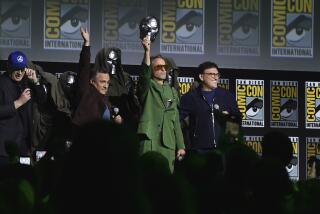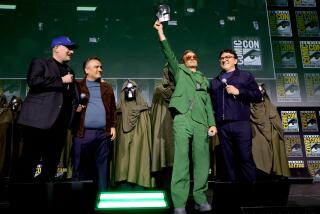‘Iron Man’
IRON MAN? This is the name for a superhero? Rather than sounding like a six-pack of blue-collar beer, shouldn’t the handle for a fighter for truth and justice be something sleek and modern like Titanium Man or even Uranium Al? Isn’t Iron Man a little old-school for today’s computer-generated movie franchise world?
Don’t tell that to the folks at Marvel, whose characters have made a fortune at the box office -- $4.9-billion worldwide gross to date, thank you very much -- starring comic book heroes who were in their prime 40-plus years ago, before much of today’s core audience was even alive. Much as we might like to avoid the fact, the comic book movie is clearly the genre of our time.
So here comes “Iron Man,” following gamely in the footsteps of “Spider-Man,” “X-Men,” “Fantastic Four,” “Hulk,” “Daredevil” and the other Marvel heroes. Directed by Jon Favreau, it’s got an energetic, engaging performance by Robert Downey Jr. in the starring role and such an elaborate series of Iron Man suits for him to wear that it takes 10 pages in the production notes to fully describe them.
But though “Iron Man” is diverting enough in the comic-book-movie mode, there is one thing it doesn’t have, and that is dramatic unity. Unlike the irreducible element that is its namesake, “Iron Man” the movie is an alloy, a combination of several different and disconnected components that don’t manage to unite to make a coherent whole.
Though this feeling is inescapable throughout the film, a key part of the reason isn’t clear until the final credits reveal that two different teams of writers (Mark Fergus and Hawk Ostby, and Art Marcum and Matt Holloway) worked on the film. And not just worked on it in any conventional way. As an article in Script magazine details, they happily toiled without meeting on separate-but-equal versions of the script that were eventually merged by Marvel and the director.
In theory, this “one from column A, one from column B” approach might have worked, but in this case it does not. Though many of the film’s sequences are fine in and of themselves, when joined together they tend to seem not of a piece, unable to provide the single sweeping narrative we crave. Favreau, who has worked in different genres with mixed success (yes to “Elf,” no to “Zathura”), may not have noticed, and, frankly, audiences likely will not either, but the situation remains.
Diversity of tone hardly seems a problem when “Iron Man” opens with high-energy sequences that introduce Downey as billionaire inventor/playboy/merchant of death Tony Stark, a second-generation weapon manufacturer who lives in a Malibu house the size of a small city and spends his free time womanizing, gambling and accepting accolades for being a visionary genius and American patriot.
With his weakness for glib one-liners and throwaway comments (“I need it, buy it, store it,” he says of a potential Jackson Pollock purchase), this part has been nicely tailored to Downey’s talents and is a great deal of fun as a result.
If Downey slips easily into cartoon mode, his big-name costars have more mixed experiences. Jeff Bridges clearly relishes being Tony’s full-bearded and bald partner, Obadiah Stane, while Gwyneth Paltrow runs hot and cold as Tony’s loyal assistant Pepper Potts, and the gifted Terrence Howard looks noticably uncomfortable as Tony’s long-suffering pal Lt. Col. James “Rhodey” Rhodes.
Sadly, the film’s fun-loving party animal Tony is not with us for very long.
Traveling to Afghanistan (actually, it’s nearby Lone Pine, Calif.) to demonstrate a new weapon system, Tony gets kidnapped by noticeably cranky jihadists who consider him “the most famous mass-murderer in the history of America” and want him to build them one of his “masterpieces of death” in the dank cave they’ve imprisoned him in.
Though his heart has been damaged by (how ironic!) shrapnel from one of the bombs his company created, Tony, it turns out, is not a man to mess with. Turning dour and serious, he fools the jihadists, who show themselves to be bears of very little brain, and constructs his first Iron Man suit, which makes him look like an especially fierce refrigerator-freezer.
Once he’s back in the U.S. of A., it turns out that time spent in the cave has turned our hero into yet another Tony, this one a touchy-feely guy who believes he has “more to offer the world than making things blow up.”
He promptly retreats to his Malibu basement, where he spends far too much of the movie’s time in the trial-and-error process of getting his new, improved titanium-and-gold Iron Man suit to work.
I understand that this film is an origin story, but even so, enough is enough.
Yet more Tonys emerge in the rest of “Iron Man,” from the Human Rights Watch monitor on steroids who protects innocents in Afghanistan to the superhero who fights a behemoth called Iron Monger in the film’s elaborate finale.
With all these Tonys running around, it’s not surprising that “Iron Man” feels more convoluted than it needs to be.
Downey’s unbeatable charisma makes these problems less troublesome than they would be otherwise, but wouldn’t it be nice if they didn’t exist at all?
“Iron Man.” MPAA rating: PG-13 for some intense sequences of sci-fi action and violence and brief suggestive content. Running time: 2 hours, 6 minutes. In general release.
More to Read
The biggest entertainment stories
Get our big stories about Hollywood, film, television, music, arts, culture and more right in your inbox as soon as they publish.
You may occasionally receive promotional content from the Los Angeles Times.











